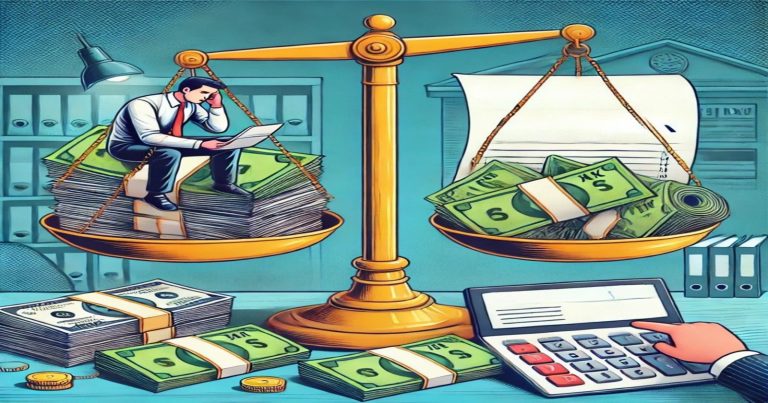A surcharge under income tax means an additional tax you pay if your income is over a certain limit. It is levied on top of the base income tax. Surcharges increase revenue from high income earners and corporations. This ensures progressive taxation, whereby higher earners pay more towards the economy. When an individual’s, Hindu Undivided Family (HUF), firm and company annual income exceeds the specified threshold, a surcharge is charged on income tax based on the individual’s income.
The surcharge rate differs by entity type and income levels. These rates are revised by the Indian government from time-to-time in the Union Budget. As per the report, individuals who earn above Rs. 50 lakh and companies with large profits are liable to pay a surcharge. Taxpayers can avail marginal relief as well to alleviate excessive tax burden as a result of the surcharge.
What is Surcharge on Income Tax?
A surcharge on income tax is levies on individuals and businesses making more than a certain amount, and are added on in addition to normal income tax. This is only for those whose aggregate income exceeds the specified amount. While cess is charged for all taxpayers, surcharge is charged on high-income taxpayers only. This additional income is used by the government towards welfare and developmental activities.
The main features regarding surcharge on income-tax are:
- It’s not all of income that must be taxed, but only this percent.
- It applies only if taxpayers ‘ income exceeds a certain limit.
- According to different levels of taxes, different levels surcharge rates are used in the calculation
- It includes a taxpaying individual or his wife or dependent children with full control of resources
- Excessive tax burden gets some marginal relief. If your tax bill goes over a certain percentage of your income—that’s when fizzing relief kicks in
Surcharge is computed on tax payable not including health and education cess. The government employs this method of taxation to see that the wealthy elite contribute more to national prosperity.
Surcharge on Income Tax for Individuals
Individual income tax surcharge is levied based on the total taxable income of an individual. If an individual’s total income exceeds a certain limit, there is an extra charge of tax imposed. This surcharge ensures that high income earners contribute more towards the tax system which is a structure with a progressive rate for governments and states. Before applying cess, the rate of surcharge is adjusted to reflect the income slab.
- Resident individuals
- Hindu Undivided Families (HUFs)
- Non-resident individuals (NRIs)
- Association of Persons (AOPs)
- Body of Individuals (BOIs)
In addition to the basic in come tax rate, a surcharge is levied on individuals that come within different earnings > brackets pay different surcharge rates
For example, an individual earning 60 lakhs a year will pay 10% surcharge in the total amount of income tax. However someone who makes above Rs. 5 crore will be subject to a further 25% surcharge;
The surcharge structure ensures that those with higher income levels pay more in the way of taxes. But taxpayers who just stay above the bar can be eligible for > marginal relief and that this would lower their surcharge while being reassured on these aspects and by several provisions to minimize their tax burden as well.

Rates of Surcharge
Individual surcharge rates vary depending on income levels. The higher the income, the higher the percentage of tax as a surcharge. The government adjusts these from time to time according to economic policies. The following is a table indicating applicable rates:
| Income Range | Surcharge Rate |
| Up to Rs. 50 lakh | No Surcharge |
| Rs. 50 lakh – Rs. 1 crore | 10% |
| Rs. 1 crore – Rs. 2 crore | 15% |
| Rs. 2 crore – Rs. 5 crore | 25% |
| Above Rs. 5 crore | 37% |
For domestic companies and firms, the surcharge rates vary as follows:
| Taxable Income | Surcharge Rate |
| Up to Rs. 1 crore | No Surcharge |
| Rs. 1 crore – Rs. 10 crore | 7% |
| Above Rs. 10 crore | 12% |
Surcharge is levied on the amount of tax payable and not on the gross income. Also, health and education cess (4%) is levied over the tax and surcharge.
How to Calculate Surcharge on Income Tax?
Surcharge is computed on the total tax to be paid. It is not calculated on total income but on the tax liability minus health and education cess. Formula of computation of surcharge is:
Surcharge = (Income Tax Payable) × (Surcharge Rate)
For example:
- Assuming the annual income is Rs. 1.5 crore. The minimum tax liability (based on slab rates) would be Rs. 42,12,500.
- The surcharge to be paid is 15% of Rs. 42,12,500, which is Rs. 6,31,875.
- Adding the surcharge, the total tax charged is Rs. 48,44,375.
- Cess on health and education (4%) is then charged on the above amount.
Example Calculation
Let’s assume:
- Total taxable income: Rs. 2.5 crore
- Tax before surcharge: Rs. 74,12,500
- Surcharge: 25% of Rs. 74,12,500 = Rs. 18,53,125
- Total tax after surcharge: Rs. 92,65,625
- Adding 4% cess: Rs. 96,36,250
Thus, the final tax liability is Rs. 96,36,250.
Marginal Relief on Surcharge
The marginal relief on the surcharge provides relief to the taxpayers who have an income just above the surcharge level. This means they avoid being taxed excessively as a consequence of that. Where a surcharge is liable to apply, marginal relief will be allowed if otherwise there might result an excessive tax take.
Marginal relief applies at the point when:
- The additional tax due to surcharge exceeds any income above the threshold.
- The taxpayer’s income foams just over the margarine.
How Marginal Relief Works
With a sum of ₹51 lakh, the 10% rate is applicable. But those additional taxes paid as a result of the surcharge ought not to exceed the additional income (₹ 1 lakh more than $50 lakhs ). Marginal relief makes sure that the tax isn’t unfairly raised.
For example:
- Tax before surcharge: Rs. 13,12,500
- Surcharge at 10%: Rs. 1,31,250
- Total tax: Rs. 14,43,750
- Excess income over threshold: Rs. 1 lakh
- Since the surcharge increase is more than Rs. 1 lakh, marginal relief reduces it.
Marginal relief is calculated in such a way that the final tax liability remains just slightly above the normal tax without surcharge.
Relevance to ACCA Syllabus
The ACCA syllabus covers taxation, corporate finance, and financial reporting, taxation surcharge is a key issue in this connection. Knowing this requirement aids income tax planning, management decision making, and also has an effect on how one is able to comply with tax laws. The importance of such laws can be appreciated in certain Subjects like TX (Taxation), and ATX (Advanced Taxation) -which take the taxes of individuals and corporations as their object.
Surcharge on Income Tax ACCA Questions
Q1: Why is a surcharge on income tax mainly imposed?
A) To raise government revenue from all taxpayers
B) To levy extra tax on high-income earners
C) To cut tax payment by corporations
D) To abolish indirect taxation
Ans: B) To levy extra tax on high-income earners
Q2: In ACCA Taxation syllabus, which type of taxpayer is hit hardest by surcharge on income tax?
A) Individuals with income below the tax-free allowance
B) Companies with taxable profits below the limit
C) High-net-worth individuals and companies with income above the limit
D) Non-resident individuals with foreign-source income
Ans: C) High-net-worth individuals and companies with income above the limit
Q3: In India, what is the rate of surcharge on individuals earning over ₹5 crore?
A) 10%
B) 25%
C) 37%
D) 15%
Ans: C) 37%
Q4: Surcharge on income tax is charged on which figure?
A) Gross income
B) Total taxable income
C) Tax liability before cess
D) Net profit after tax
Ans: C) Tax liability before cess
Relevance to US CMA Syllabus
The US CMA (Certified Management Accountant) course of study focuses on cost management, taxation, and financial planning. In Part 2 – Financial Decision Making, the surcharge on income taxes becomes part of relevant materials when it comes to tax strategies and corporate tax avoidance. CMAs must fully grasp how that surcharge affects the financial performance of a company or the after-tax profits reported in their quotations.
Surcharge on Income Tax US CMA Questions
Q5: What effect does surcharge on income tax have on a company’s financial statements?
A) It enhances the operating income of the company
B) It decreases the net profit by augmenting tax expenses
C) It has no effect on financial statements
D) It is accounted as an asset in the balance sheet
Ans: B) It decreases the net profit by augmenting tax expenses
Q6: An American company has taxable income of $15 million. When the surcharge threshold is $10 million, what will it do?
A) The company will pay higher tax as a result of surcharge
B) The company is not subject to surcharge
C) Surcharge can only be levied on individuals, not on companies
D) The company has to pay the surcharge on the total income
Ans: A) The company will pay a higher tax rate because of surcharge
Q7: What is a crucial factor in tax planning for surcharge under CMA Part 2 – Financial Decision Making?
A) Income shifting strategies
B) Writing off expenses after paying taxes
C) Capital expenditure avoidance
D) Cutting down the cost of inventory
Ans: A) Income shifting strategies
Relevance to CFA Syllabus
Taxation is part of Corporate Finance and Financial Reporting & Analysis in the CFA (Chartered Financial Analyst) program. Investors and financial analysts are required to estimate how the effective tax rate of a company, including surcharge, affects valuation, financial modeling, and calculations of returns.
Surcharge on Income Tax CFA Questions
Q8: Suppose that a firm possesses a heavy corporate tax surcharge. How would this affect its valuation?
A) Reduces net income and decreases earnings per share
B) It is added to net profit margin
C) Valuation of the company is unaffected by the passage of time
D) Favorable investor views are developed
Ans: A) Reduces net income and decreases earnings per share
Q9: Why is the income tax surcharge included in creating a model to forecast cash flows?
A) It has an impact on after-tax income, which influences how to determine free cash flow
B) It’s an indirect cost, therefore you do not include it
C) Surcharges have no effect on cash flows
D) Direct impacts of a tax surcharge
Ans: A) It has an impact on after-tax income, which influences how to determine free cash flow
Q10: If a firm is subject to a surcharge, what will investors be on the lookout for in financial reports?
A) The effective tax rate on the income statement
B) Whether selling & admin costs are included as operating expenses
C) Non-operating income is up
D) Debt-to-equity ratio has fallen
Ans: A) The effective tax rate on the income statement
Relevance to US CPA Syllabus
The US CPA syllabus addresses taxation in great detail, especially in the Regulation (REG) section, which addresses individual and corporate taxation. Knowledge of surcharge is important for tax planning, compliance, and counseling firms on tax efficiency.
Surcharge on Income Tax US CPA Questions
Q11: Which part of the US CPA exam does surcharge on income tax go under?
A) Auditing & Attestation (AUD)
B) Regulation (REG)
C) Business Environment & Concepts (BEC)
D) Financial Accounting & Reporting (FAR)
Ans: B) Regulation (REG)
Q12: Who of the following categories taxpayer are most likely to face surcharge on income tax?
A) A small business has an income of $500,000
B) A corporation with $12 million of taxable income
C) A taxpayer whose income is less than the standard deduction amount
D) The losses incurred by a business in its founding year
Ans: B) A corporation with $12 million of taxable income
Q13: What part do marginal relief on surcharge play in the way a taxpayer thinks?
A) It cancels the surcharge for any taxpayer
B) It reduces the total tax increase not only in proportion but also to win over threshold
C) It increases the tax burden distinctly having surcharge
Ans: B) It makes sure that the total increase in tax is not a disproportionate burden on the income above limit
Q14: How does surcharge come into play in tax planning in US CPA taxation?
A) It will force high-income individuals to change the way they get cash to reduce their tax burdens.
B) It does nothing but the demand for tax planning
C) It is only applicable to capital gains.
D) It has no effect on individual taxpayers.
Ans: A) It leads high-income individuals to shift their income in order to lower their tax burden


